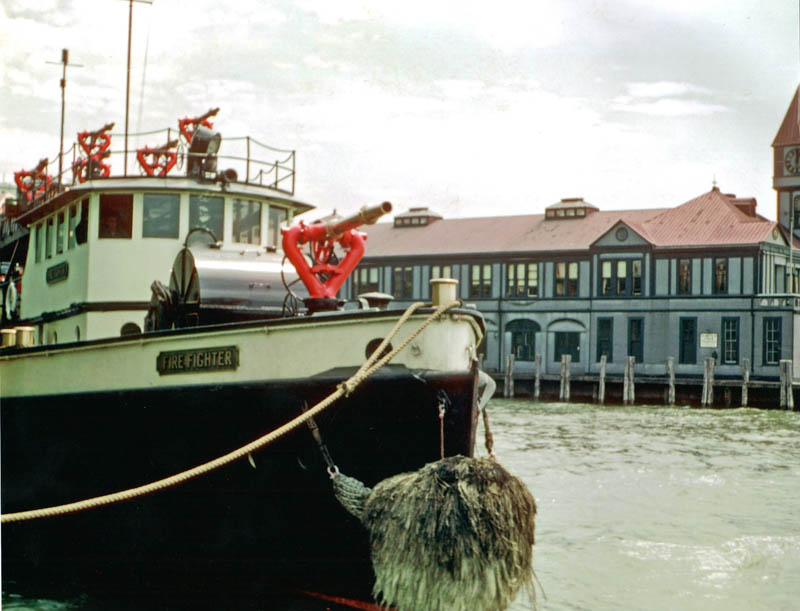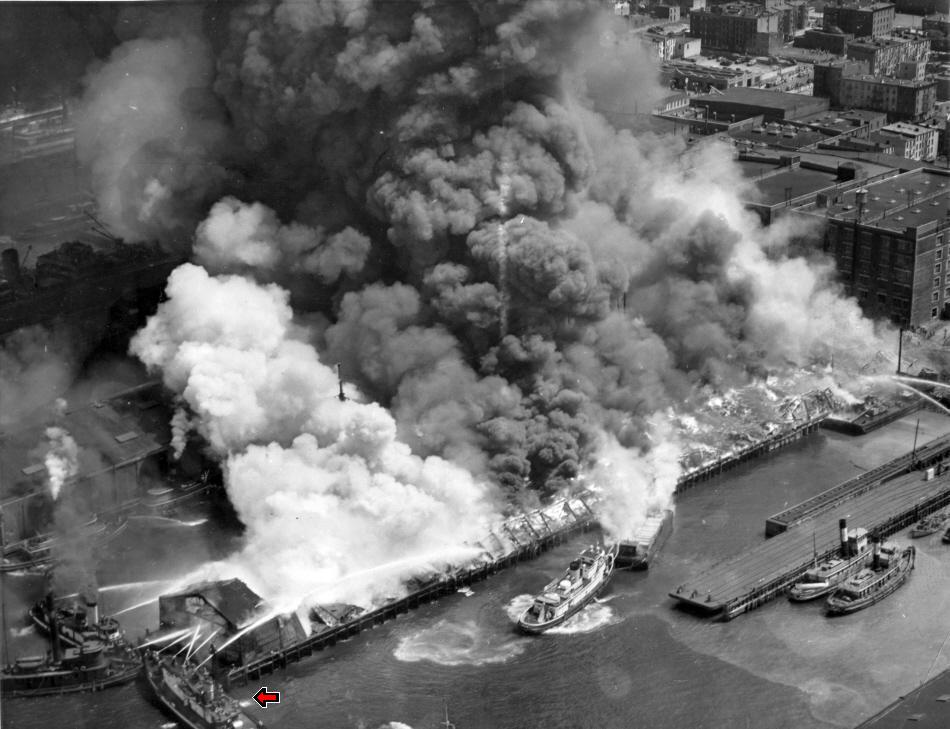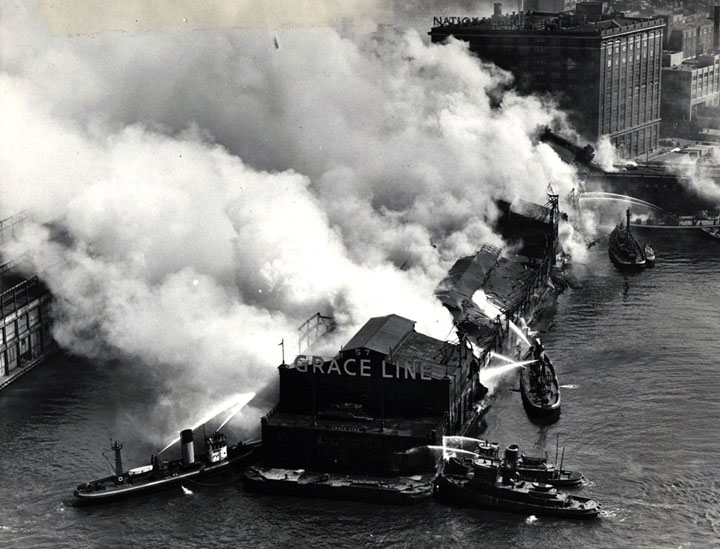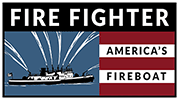
Fire Fighter in service as Engine 57 at Pier 1, Manhattan. Note her as-built black hull color and polished brass bitts and hose reel.
Peacetime
Officially entering FDNY service at 0900hrs on November 16, 1938 as Engine 57 at Pier 1 in the Battery, Fire Fighter became the first-due fireboat for much of the Port of New York, which at the time was centrally located along the Hudson and East River shorelines of Manhattan, Brooklyn and Queens. With her crew eager to make use of the capabilities they had spent the previous month evaluating and exercising, the Fighter’s first call to action was not exactly the raging inferno she was designed to combat: Call #1 was a dispatch to wrangle a runaway fully-loaded oil barge riding the ebb tide down the Hudson River on the evening of November 19th. While not a headline-grabbing event in and of itself, Fighter’s first call was typical of the routine harbor mishaps which in the wrong circumstances could lead to disaster along a waterfront teeming with cargo piers, bulk goods terminals, shipyards and watercraft of every description.
Another month of these routine calls would follow before the frigid night of January 22nd, 1939 brought with it a call for assistance from the freighter SS Silver Ash, which had caught fire while moored at the Kerr Steamship Line’s 57th Street Pier in Brooklyn. Not initially dispatched to the call as land units and the fireboat William Gaynor would have usually been up to the task, the revelation that Silver Ash was laden with several dozen barrels of poisonous Cyanide brought urgent calls for the Fire Fighter to report to the scene. Arriving shortly after 1:30AM and assuming the lead role in efforts to douse the rapidly advancing flames, Fighter’s crew fought single-digit temperatures and heavy ice for over 13 hours before the fire was extinguished.
Victorious over her first fire, Fire Fighter resumed her station at the Battery where she spent the balance of the next year guarding harbor traffic and responding to routine calls. The exception to this duty was her deployment to the 1939 World’s Fair at Flushing Meadows, where she became something of a celebrity among the people of New York as she served as both a fire protection asset and a heavily-visited exhibit of her own revolutionary design and capabilities.
The light atmosphere of the World’s Fair was not to be long-lived however, as less than a month after leaving her fair duty the Second World War began in Europe, bringing with it the grim reasoning behind the Fighter’s powerful firefighting capability. Though the United States would remain officially neutral for the next two years, New York Harbor was soon busy with cargo ships carrying supplies of all kinds to Europe, and along the Bronx, Brooklyn, and Staten Island shorelines long-dormant shipyards were once again humming with activity as the United States ramped up the production of warships. Keeping an ever watchful eye over the nonstop activity, Fire Fighter and her marine division fleetmates soon found themselves protecting a major war material supply port which was now lying on the front lines in the Battle of the Atlantic.

A trans-Atlantic convoy of Tankers and Freighters gathers in the Verrazano Narrows prior to departure for Europe in 1940.
Wartime
By 1941 New York Harbor was teeming with ships of all kinds engaged in the effort to carry supplies to the European allied powers. Despite the presence of so many ammunition-laden cargo vessels, fuel-laden tankers and cargo-laden transports crowding the harbor with warships of every description all but guaranteeing a major open-water mishap, the majority of Fire Fighter’s calls during this hectic time came instead from vessels in distress while pierside. With the risk of fire aboard a general cargo ship or in a pier shed already high for litany of reasons prior to the war, the subsequent demand for raw materials in Europe meant that most breakbulk freighters and pier houses were loaded and often times overloaded with multiple types of cargo, most of which quickly turned into a fuel source once ignited. As a result, time and again small fires that would have otherwise been contained quickly grew into raging infernos that claimed ships, property and lives along the wartime waterfront.

Fire Fighter (indicated by the red arrow) works the Pierhouse fire at the Baltic Line Pier, following the removal of SS Panuco.
Such was the case in August of 1941, when Fire Fighter was dispatched to fight a catastrophic and multiple-fatality fire aboard the freighter SS Panuco at Brooklyn’s Pier 27, just across the East River from her post at Pier 1. Though her response time was measured in minutes, by the time Fire Fighter arrived onscene the Panuco, along with twelve wooden barges alongside and much of the Baltic Line’s wooden pierhouse were heavily aflame with fire rapidly spreading. Working in concert with her fellow fireboats, US Coast Guard craft and commercial Tugboats to keep the fires away from the hundreds of trapped stevedores until they could be rescued, Fire Fighter and her crew would spend much of the next 36 hours battling the fire on the pierhouse and the derelict vessel as it burned to the waterline on Bay Ridge Flats.
Months later, a surprising call came from Pier 88 on Manhattan’s West Side on the cold and blustery morning of February 9, 1942 – the troopship USS Lafayette – formerly the ocean liner SS Normandie – had caught fire while being stripped of her once-opulent fittings prior to her military service. Arriving onscene and finding the once-proud ship engulfed in flames from stem to stern, Fire Fighter joined almost every fireboat in the FDNY fleet to battle the blaze. Unleashing her full pumping capacity, she contributed to extinguishing the numerous fires burning on the enormous ship. Successful to a fault, Fire Fighter certainly contributed her share to the huge volume of water pumped aboard the burning liner which eventually caused it to capsize, where she would remain until late 1943.

Fire Fighter snuffing hotspots on the the still-burning hulk of the former SS Normandie after her fire and capsizing at Pier 88.
Called upon slightly over a year later to battle yet another major vessel fire, Fire Fighter was dispatched with fireboat John J. Harvey on April 26, 1943 to the Caven Point Army Terminal, where the ammunition-laden freighter SS El Estero had caught fire and was burning out of control. Knowing in advance that the ship was carrying a mixed load of explosives topping 1,400 tons, Fire Fighter’s crew ignored the clear and imminent danger posed by the detonation of the ship’s cargo and immediately set about drowning her flaming cargo from alongside. Using her stern-mounted tower monitor for its designed purpose of reaching over vessel bulwarks and into cargo holds to rapidly flood the burning holds, Fire Fighter and the Harvey used their combined 38,000gpm pumping capacity to keep on top of the flames as the ship was towed clear of the ammunition depot by a quartet of commercial tugboats. Eventually reaching the shallow waters of Robbins Reef, Fire Fighter and the Harvey flooded and sank the El Estero, snuffing her onboard fires and ending what is perceived to have been the single greatest threat to New York Harbor during the entire Second World War. All ten crew aboard Fire Fighter would receive formal commendations and awards for their selfless devotion to duty in fighting the fire aboard the El Estero.
Postwar
The end of the Second World War brought a welcome reduction in the number of explosive-laden vessels clogging New York Harbor, and in time the once frantic pace of wartime operations eased and was replaced with the spike in postwar shipping supporting the rebuilding effort in both Europe and Asia. Busy as ever with routine calls and minor fires in the initial postwar years, Fire Fighter also battled major pier fires in 1946 at the Staten Island Ferry Terminal, in 1947 at the Grace Line Pier in Manhattan and in 1954 at Red Hook in Brooklyn.

Fire Fighter (closest to the shoreline on the right side) battles the multi-alarm fire at Grace Line’s Pier 57 on September 29, 1947
As the 1940’s gave way to the 1950’s, huge changes in the nature of merchant shipping began to manifest across the New York waterfront, as the multitude of surplus ships built during the war and prewar years began to be replaced by newbuild tonnage which tended to be larger and deeper vessels than what could be accommodated at the tightly packed and shallower piers along the East and Hudson Rivers. By the mid-1950’s a steady exodus of steamship lines was well underway from Manhattan as companies relocated to wartime-built or upgraded facilities along the Brooklyn waterfront along Upper New York Bay. Eager to keep Fire Fighter as close as possible to the center of marine trade in New York Harbor, the FDNY Marine Unit decided to reassign Fire Fighter to Engine 223 at the Bush Terminal in 1955, though she would make a brief detour up the East River to serve at Gracie Mansion as Engine 78/Marine Unit 5 before reporting to her new post.

